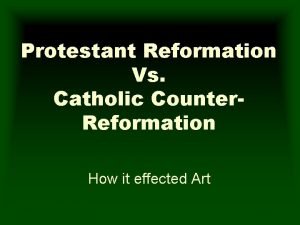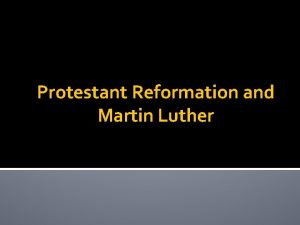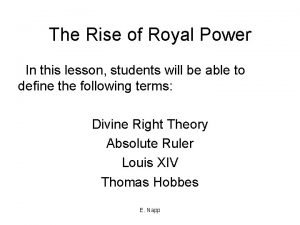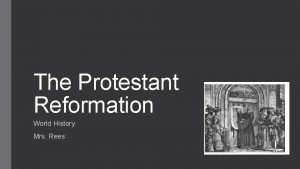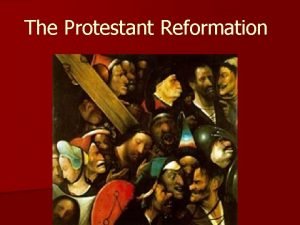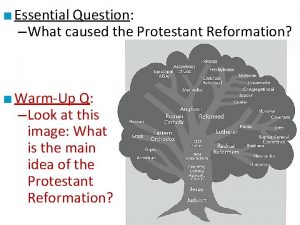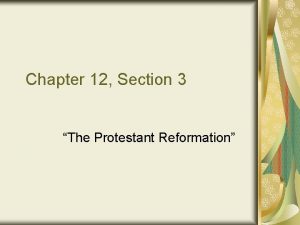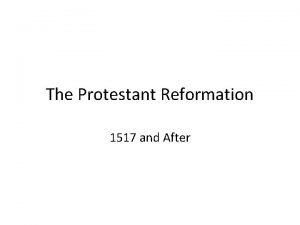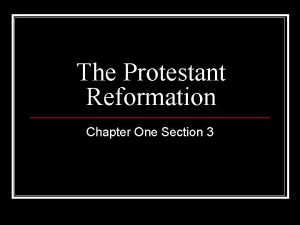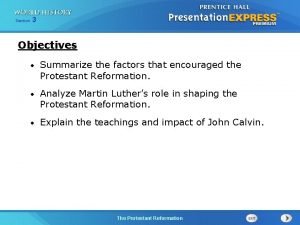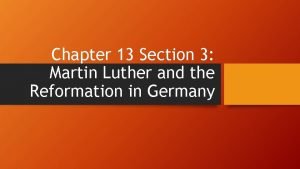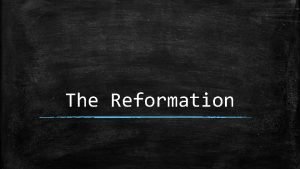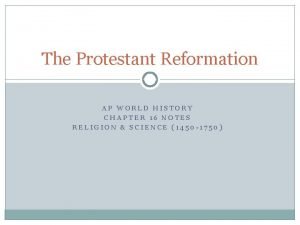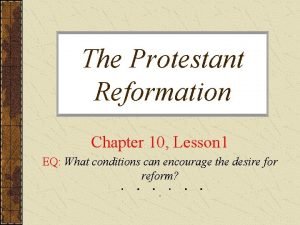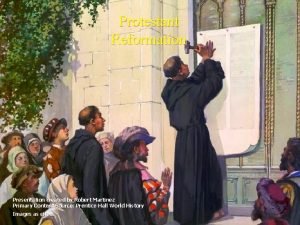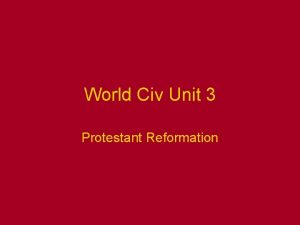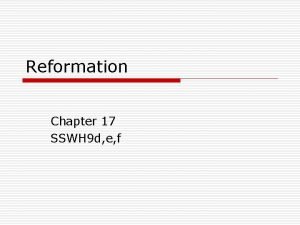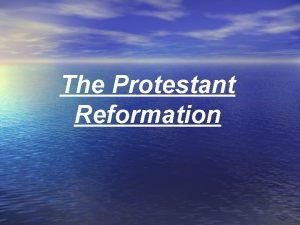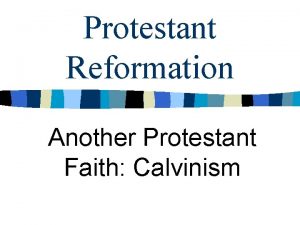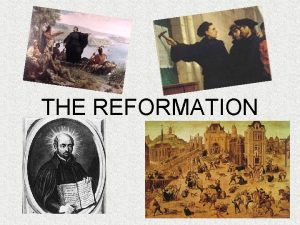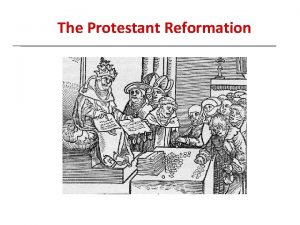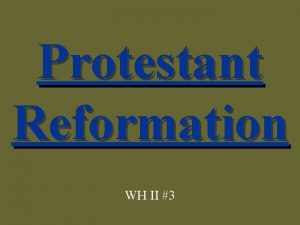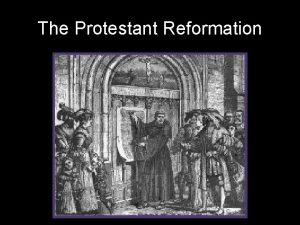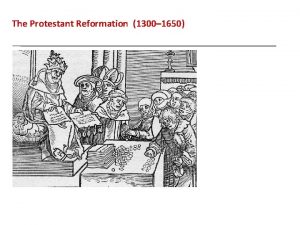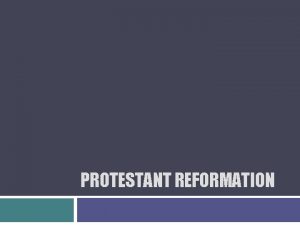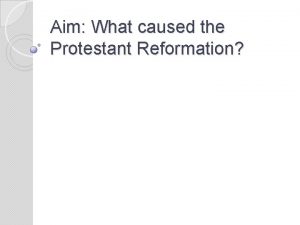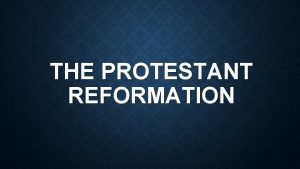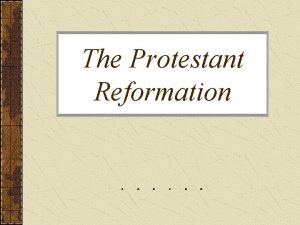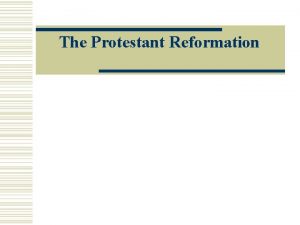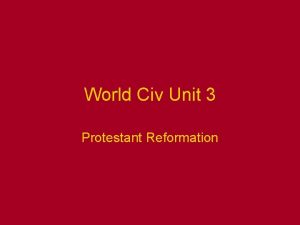The Protestant Reformation The Protestant Reformation Started in

















- Slides: 17

The Protestant Reformation

The Protestant Reformation � Started in 1517 by a German priest named Martin Luther � Causes: Church Corruption � Selling of Indulgences � 1/3 of land in Europe owned by Church � Nepotism- promoting of family w/n church � Simony- selling church offices � Issued a document called the 95 Theses Nailed it to a church door in Wittenberg, Germany Outlined his issues with the Catholic Church #27. They are wrong who say that the soul flies out of Purgatory as soon as the money thrown into the chest rattles. #62. The true treasure of the Church is the Holy Gospel of the glory and grace of God. # 66. The treasures of indulgences are nets, wherewith they now fish for the riches of men. # 86. Again; why does not the Pope, whose riches are at this day more ample than those of the wealthiest of the wealthy, build the Basilica of St. Peter with his own money rather than with that of poor believers.

The Protestant Reformation �Martin Luther was critical of the following abuses conducted by the Catholic Church: The selling of indulgences Pope Leo X (above) sold church positions and indulgences to raise money to rebuild St. Peter’s Basilica in Rome Selling church positions Selling indulgences = certificates issued by the church that reduced or canceled punishment for a person’s sins people would buy them to ensure going to Heaven Luxurious life of the popes Corruption and immorality of some clergy

Martin Luther’s Beliefs �Salvation = came through faith alone; God’s grace is freely and directly granted to believers �Source of religious authority = the Bible (as interpreted by the individual), not the Pope or church leaders �These ideas = created a massive rift between Catholic and Protestant Christianity

Spread of Protestantism �Reformation thinking spread quickly within and beyond Germany thanks to the invention of the printing press by Johannes Gutenberg �Luther’s 95 Theses, many pamphlets, and his German translation of the New Testament were soon widely available �As the movement spread to the rest of Europe, it splintered, creating a variety of different Protestant churches Ex: Lutheran, Calvinist, Anglican, Quaker, Anabaptist, Puritan, etc.


Spread of Protestantism

Calvinism �Established by John Calvin in Switzerland �Preached predestination = God determines the fate of every person

The Anabaptists �Denied the authority of local governments Refused to hold office, bear arms, or swear oaths �Many lived separate from society viewed it as sinful �Baptized adult members only An Anabaptist Immersion

The Church of England �King Henry VIII (ruled from 1509 -1547) wanted a divorce from his first wife (Catherine of Aragon) She had 6 children -- only 1 survived (a girl named Mary) King wanted a male heir to the throne King thought Catherine of Aragon was too old and he wanted to marry the young, beautiful Anne Boleyn instead Problem = the Pope refused to grant the King a divorce

The Church of England �Result = Henry VIII separated England from the Pope and the Catholic Church Made himself head of the new “Church of England” Kept Catholic practices & traditions, but denied authority of the Pope Had supporters of the old religion killed

The Church of England �King Henry VIII had the Church of England end his marriage with Catherine & he married Anne Boleyn Anne bore him a daughter = Elizabeth I Henry VIII married 4 more times after this & only got 1 son = Edward VI (got the throne, but died in his teens)

The Church of England �Henry’s daughter Mary tried to restore Catholicism when she became Queen Burned hundreds of Protestants at the stake Nicknamed “Bloody Mary”

Anglicanism �Mary’s sister Elizabeth I became Queen when Mary died blended features of the Church of England Catholicism Religion called Anglicanism Pleased most people Radical Protestants called “Puritans” wanted to purify the English Church of all its Catholic elements ended up leaving for North America where they could have more religious freedom

Religious Conflicts � 1562 – 1598 = violent conflict between Catholics and Protestants in France �French Protestants = called Huguenots = the minority In one day (in 1572) = about 3, 000 Huguenots were massacred by Catholic mobs � 1598 = King Henry IV issued the Edict of Nantes Granted religious toleration to French Protestants Idea = soon they’d return to the Catholic Church Massacre of the Huguenots, 1572

Religious Conflicts �Thirty Years’ War (1618 - 1648) = war between Catholics and Protestants Started in Holy Roman Empire; soon took over most of Europe Destructive war 15 -30% of German population died from violence, famine, or disease � 1648 = Peace of Westphalia signed Painting of the Beginning of the 30 Years’ War Redrew some European political boundaries Said each state was independent and could control its own religious affairs

Catholic Counter-Reformation �Pope Paul III wanted to reform the Catholic Church to win back followers and stop the growth of Protestant faiths �Council of Trent (1545 -1563) 1) 2) 3) Reaffirmed Catholic teachings and practices Put an end to Church abuses, such as the selling of indulgences and church positions Put emphasis on creating a bettereducated clergy
 Protestant reformation vs counter reformation
Protestant reformation vs counter reformation Martin
Martin Protestant reformation
Protestant reformation Protestant reformation cartoon
Protestant reformation cartoon The protestant reformation crossword puzzle
The protestant reformation crossword puzzle What caused the protestant reformation?
What caused the protestant reformation? Unit 12 lesson 3 the protestant reformation
Unit 12 lesson 3 the protestant reformation Protestant reformation map
Protestant reformation map The renaissance and reformation section 3 quiz answer key
The renaissance and reformation section 3 quiz answer key What factors encouraged the protestant reformation
What factors encouraged the protestant reformation Chapter 13 section 3 the protestant reformation
Chapter 13 section 3 the protestant reformation Protestant reformation kahoot
Protestant reformation kahoot Reformation ap world history
Reformation ap world history The reformation in europe lesson 1
The reformation in europe lesson 1 Unit 3: martin luther & the protestant reformation
Unit 3: martin luther & the protestant reformation Protestant reformation
Protestant reformation Protestant beliefs
Protestant beliefs Excommunication def
Excommunication def
